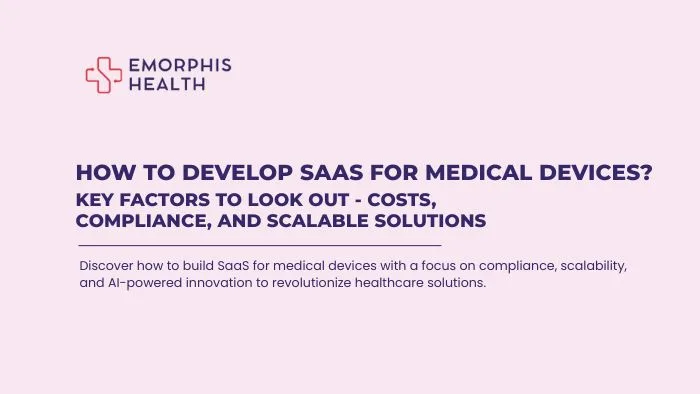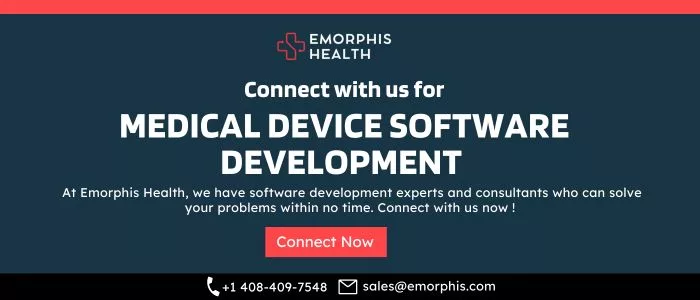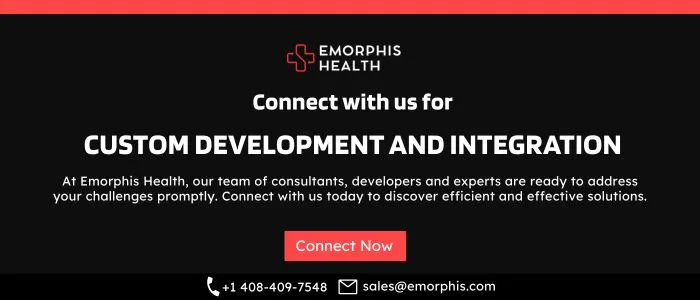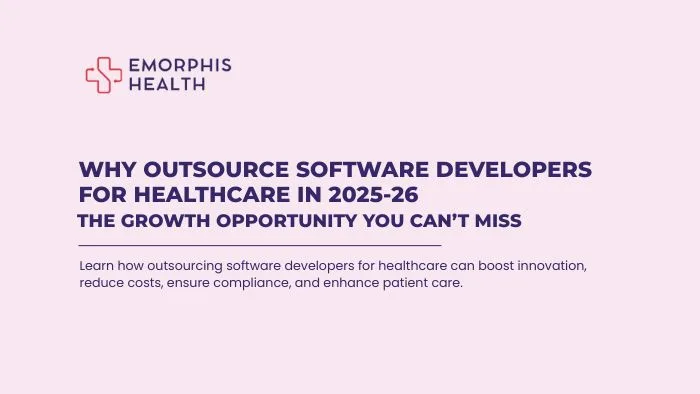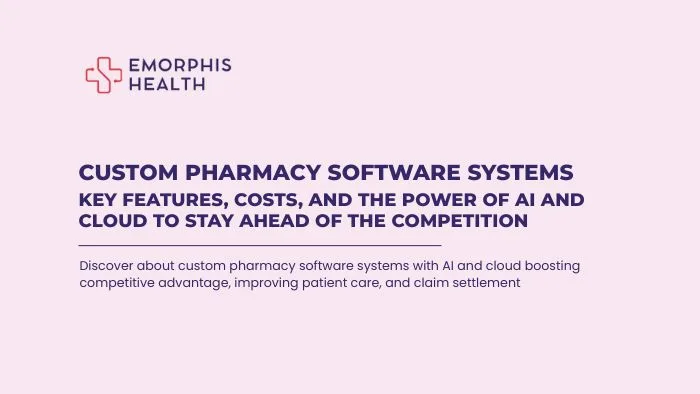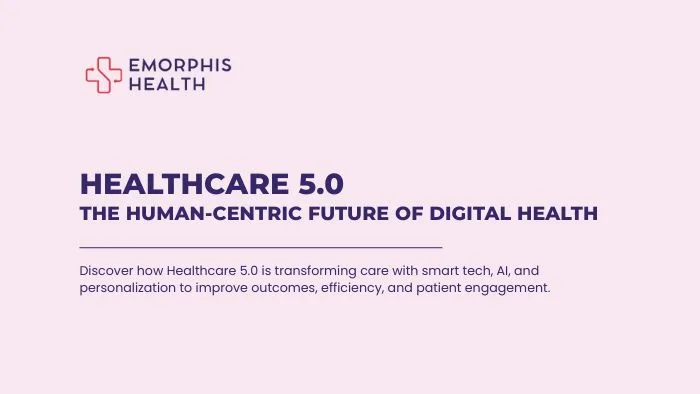Why SaaS for Medical Devices is Growing in 2025-26
See Contents
- 1 Why SaaS for Medical Devices is Growing in 2025-26
- 2 What Does It Mean to Develop SaaS for Medical Devices?
- 3 Market Drivers and Opportunities in SaaS for Medical Devices
- 4 Step-by-Step Process to Develop SaaS for Medical Devices
- 5 Key Features and Architecture Considerations
- 6 Compliance and Regulatory Requirements
- 7 Cost Breakdown to Develop SaaS for Medical Devices
- 8 Future of SaaS for Medical Devices
- 9 Why Partnering with an Expert Matters
- 10 Conclusion
Healthcare technology is undergoing a massive shift, and one of the strongest trends is the adoption of Software-as-a-Service (SaaS) models in medical devices. Companies that develop SaaS for medical devices are not only improving clinical workflows but also creating scalable, cloud-based platforms that can integrate with hospitals, diagnostic tools, and patient monitoring systems.
In 2025-26, the demand to develop SaaS for medical devices has increased because of three key reasons:
- Regulatory Push: Compliance with healthcare standards like HIPAA, GDPR, and FDA rules is easier to maintain through centralized SaaS platforms.
- Market Demand: Hospitals and healthcare providers prefer subscription-based solutions that reduce upfront costs.
- Innovation: SaaS enables medical device companies to add AI, analytics, and remote patient monitoring capabilities without hardware upgrades.
For medical device manufacturers and healthcare software companies, the ability to develop SaaS for medical devices is no longer a “nice to have”, it has become a competitive necessity.
What Does It Mean to Develop SaaS for Medical Devices?
To put it simply, when you develop SaaS for medical devices, you are building cloud-based applications that connect medical hardware with intelligent software. Instead of just selling devices, manufacturers can offer subscription-based services that:
- Store patient data securely in the cloud.
- Enable real-time monitoring through connected dashboards.
- Provide updates and new features without physical recalls.
- Allow integration with Electronic Health Records (EHRs) and hospital systems.
This approach not only changes revenue models but also ensures that medical devices remain future-ready. For example, a company that develops a SaaS-enabled glucose monitor can continuously enhance its software to provide AI-driven predictions, without requiring patients to buy a new device.
Market Drivers and Opportunities in SaaS for Medical Devices
The healthcare industry is rapidly moving toward digitization, and this shift is fueling the need to develop SaaS for medical devices. Several market forces are shaping this transformation:
1. Rising Demand for Remote Healthcare
Post-pandemic, remote patient monitoring has become a priority for hospitals and home-care providers. Companies that develop SaaS for medical devices can enable real-time tracking of vitals, smart alerts, and data sharing across care teams.
2. Subscription-Based Business Models
Traditionally, medical devices have been sold as one-time products. With SaaS, manufacturers can unlock recurring revenue by offering devices as part of a service package. This trend makes it financially attractive for healthcare startups and large enterprises alike to develop SaaS for medical devices.
3. Regulatory Incentives and Data Security
Global regulators are emphasizing secure, interoperable, and compliant systems. SaaS provides centralized compliance management, making it easier to meet HIPAA, GDPR, FDA, and MDR requirements. For this reason, both innovators and established players are focusing on how to develop SaaS for medical devices without running into regulatory risks.
4. Integration with AI and Big Data
Healthcare generates vast amounts of data. When companies develop SaaS for medical devices, they gain the ability to process this data with AI, predictive analytics, and machine learning. This leads to smarter diagnostics, personalized treatments, and higher patient engagement.
5. Global Market Growth
According to recent reports, the healthcare SaaS market is projected to grow at double-digit rates through 2030. For medical device companies, the opportunity to develop SaaS for medical devices translates to tapping into a multi-billion-dollar market that combines hardware innovation with software scalability.
With the market forces firmly in place, the next big question for innovators and healthcare software companies is how to actually develop SaaS for medical devices. While the opportunities are vast, success requires a structured approach that combines technical architecture, compliance, and user-centered design.
Let’s break down the step-by-step process that companies should follow.
Step-by-Step Process to Develop SaaS for Medical Devices
Step 1: Define Business Objectives and Use Cases
When organizations decide to develop SaaS for medical devices, the very first step is to align technology with business strategy. This is not just about coding or cloud hosting — it’s about designing a product that solves a real clinical or operational problem.
Example Use Cases:
- A SaaS platform for ventilators that allows remote monitoring of ICU patients.
- A subscription-based diabetes management system connected to glucose monitors.
- Cloud-based SaaS for imaging devices where radiologists can share results securely.
Clearly identifying the problem ensures that the SaaS product not only appeals to healthcare providers but also delivers value to patients.
Step 2: Regulatory and Compliance Planning
Healthcare SaaS is unique because compliance isn’t optional — it defines whether your product can even enter the market. Companies aiming to develop SaaS for medical devices must map compliance at the start:
- HIPAA (US): Ensures patient data confidentiality and sets standards for storage and transfer.
- FDA (US): If the SaaS influences clinical decisions, it may be classified as Software as a Medical Device (SaMD).
- MDR/ISO 13485 (EU): Critical for European Union market clearance.
- HL7 & FHIR Standards: Ensure data interoperability between SaaS applications, devices, and hospital systems.
Pro Tip: Non-compliance can lead to millions in fines and blocked market entry. Building compliance into workflows from the design phase prevents costly reengineering.
Step 3: Design the SaaS Architecture
A successful SaaS platform is built on a scalable and secure architecture. When companies develop SaaS for medical devices, the architecture should address reliability, performance, and integration.
- Cloud Platform Selection: AWS, Microsoft Azure, and Google Cloud are the top choices because they already offer HIPAA-compliant services.
- Multi-Tenancy: Essential if your SaaS will be used by multiple hospitals or clinics. Each tenant (organization) should have isolated data and workflows.
- Data Storage: Use secure databases like PostgreSQL or MongoDB with built-in encryption.
- APIs: RESTful or GraphQL APIs are critical for connecting devices, EMRs, and third-party applications.
- Microservices: Designing in microservices allows modular development, making it easier to scale features independently.
Example: A SaaS platform for cardiac monitors should be able to stream ECG data securely, store it in the cloud, and provide real-time dashboards to clinicians.
Step 4: Core Feature Development
Feature development defines how well the SaaS platform will serve end-users. To develop SaaS for medical devices, focus on features that improve usability, compliance, and insights.
- Real-Time Dashboards: Doctors can view live patient data, such as blood pressure or oxygen levels.
- Custom Alerts: Automated triggers for critical health events, e.g., alerting caregivers when oxygen saturation falls below a threshold.
- Analytics & AI: Predictive analytics can forecast risks, like the chance of a stroke in high-risk patients.
- User Roles & Access Control: Different access levels for doctors, nurses, patients, and administrators ensure data security.
- Integration with IoT & Wearables: Data from smartwatches or medical-grade wearables flows into the SaaS system seamlessly.
Pro Tip: Always prioritize user experience (UX) — if clinicians find the system too complex, adoption will drop, regardless of how powerful the features are.
Step 5: Security and Data Protection
Security is the backbone of any healthcare SaaS. Without strong protections, even the best features are worthless. To develop SaaS for medical devices securely, companies must:
- Implement end-to-end encryption (AES-256 for data at rest, TLS 1.3 for data in transit).
- Use multi-factor authentication (MFA) for users, especially clinicians accessing sensitive records.
- Establish role-based access to prevent unauthorized entry.
- Maintain audit trails that log every action taken within the SaaS application.
- Conduct regular penetration testing to identify vulnerabilities.
Example: In a SaaS for MRI imaging, encryption ensures patient scans can be uploaded, viewed, and shared without risk of interception.
Step 6: Testing and Validation
Unlike consumer SaaS platforms, testing for medical SaaS is mission-critical because lives may depend on it. Companies must conduct:
- Functional Testing: Ensures data from devices flows correctly into dashboards.
- Load & Performance Testing: Verifies that the platform can handle thousands of concurrent device connections.
- Compliance Testing: Confirms alignment with HIPAA, GDPR, or FDA audit requirements.
- Usability Testing: Healthcare professionals test the SaaS in real scenarios to ensure intuitive workflows.
- Clinical Validation (if needed): For SaMD classification, clinical validation may be required before launch.
Pro Tip: Automating test cases with CI/CD pipelines reduces development time while maintaining quality.
Step 7: Deployment and Continuous Monitoring
Deployment is not just about launching the SaaS — it’s about sustaining its reliability in live healthcare environments. To effectively develop SaaS for medical devices, focus on:
- Zero-Downtime Deployment: Rolling out updates without disrupting patient care.
- Real-Time Monitoring: Tools like Datadog or New Relic track performance and uptime.
- Incident Management: Rapid response to issues or downtime.
- Feedback Loops: Gathering input from clinicians and patients to improve features.
Example: A SaaS-enabled infusion pump system should send real-time performance reports to ensure uninterrupted drug delivery.
Step 8: Scaling and Enhancing with AI
The final stage of SaaS development is scaling beyond the MVP. Medical device companies that develop SaaS for medical devices gain the most value when they expand features intelligently.
- AI Diagnostics: Leveraging machine learning for predictive outcomes.
- Predictive Maintenance: Devices connected to SaaS can notify hospitals before they fail.
- Globalization: Offering multilingual interfaces for adoption across regions.
- Integration with Insurance & Billing Systems: Streamlines reimbursement workflows.
- Personalized Dashboards: Tailoring user experiences for specialists, general practitioners, and patients.
Pro Tip: Adding AI modules not only improves functionality but also enhances market differentiation, helping companies stand out in an increasingly competitive SaaS healthcare market.
Read our case study on Solution for HealthTech Device.
Key Features and Architecture Considerations
When you set out to develop SaaS for medical devices, success depends on balancing technical robustness with user-centric design. SaaS in healthcare isn’t just about cloud hosting — it’s about building a secure, scalable, and reliable system that can handle medical data, connect with devices, and support clinical workflows without failure.
Below are the most critical features and architectural considerations:
1. Secure and Compliant Cloud Infrastructure
The foundation of any medical SaaS system is its cloud environment. The architecture should be designed for:
- HIPAA/GDPR Compliance – Use compliant services from AWS, Microsoft Azure, or Google Cloud.
- High Availability (HA) – Load balancers, failover systems, and redundancy to ensure uptime.
- Data Residency Controls – Critical for regions that require health data to stay within borders.
Example: A SaaS-enabled radiology platform must guarantee that scans are always available, even during server failures.
2. Multi-Tenancy and Data Isolation
When you develop SaaS for medical devices, the platform will often serve multiple hospitals, clinics, or device manufacturers. Multi-tenancy ensures:
- Logical Separation of Data – No overlap between clients.
- Custom Configurations per Tenant – Allowing each hospital to adapt workflows.
- Cost Efficiency – Shared infrastructure lowers operational expenses.
Pro Tip: Design multi-tenancy with encryption at both tenant and user levels for maximum security.
3. Interoperability and API Layer
Healthcare SaaS cannot exist in isolation. To be successful, the architecture must allow smooth integration with:
- EHR/EMR Systems (Epic, Cerner, Allscripts) using HL7 and FHIR standards.
- Medical Devices via IoT APIs – IoMT (Internet of Medical Things) protocols like MQTT.
- Third-Party Services – Telehealth platforms, pharmacy systems, and insurance APIs.
Example: A SaaS for insulin pumps should automatically sync patient glucose data with the hospital’s EHR in real time.
4. Scalability and Performance Optimization
Healthcare data can scale fast, especially when thousands of devices send real-time updates. When you develop SaaS for medical devices, performance must be a design priority:
- Microservices Architecture – Each function (data ingestion, analytics, reporting) runs independently.
- Auto-Scaling – Elastic scaling to handle spikes, like during a public health crisis.
- Caching Layers – Reduce latency for dashboards and analytics queries.
Pro Tip: Use container orchestration (Kubernetes) to simplify scaling and deployment.
5. Security as a Core Feature
Beyond compliance, SaaS platforms must earn the trust of users by embedding security at every layer:
- Encryption: AES-256 at rest, TLS 1.3 in transit.
- Identity and Access Management (IAM): Role-based access controls (RBAC).
- Intrusion Detection Systems (IDS): To monitor and block unauthorized activities.
- Regular Penetration Testing: Ensures security resilience.
Example: In a SaaS-enabled ECG device, patient readings must be encrypted before leaving the device, secured in the cloud, and only decrypted for authorized clinicians.
6. Advanced Analytics and AI Modules
To stand out, companies that develop SaaS for medical devices should integrate analytics and intelligence:
- Predictive Analytics – Anticipating risks like arrhythmias or respiratory issues.
- AI-driven Diagnostics – Assisting doctors with faster decision-making.
- Population Health Insights – Aggregating anonymized data for research.
Pro Tip: AI features must be transparent and explainable to meet ethical and regulatory requirements.
7. Usability and User-Centered Design
Doctors, nurses, and patients often interact with the SaaS platform under stressful conditions. This makes usability a top priority.
- Simple Dashboards: Visual, color-coded health indicators.
- Mobile-First Design: Responsive layouts for tablets and smartphones.
- Accessibility: Features for visually or hearing-impaired users.
- Offline Mode: In case of internet downtime.
Example: A SaaS dashboard for ventilators should let ICU staff check critical patient stats in just one click.
8. Continuous Updates and DevOps Pipelines
Medical SaaS must evolve quickly while maintaining stability. The architecture should support:
- CI/CD Pipelines – Automated deployment of new features.
- Version Control – Tracking all software changes for audits.
- Rollback Mechanisms – Quickly reverting to older versions in case of failures.
This approach allows companies to roll out improvements without interrupting care delivery.
By considering these technical and functional aspects, businesses can develop SaaS for medical devices that is secure, compliant, scalable, and user-friendly, ensuring both clinical adoption and market success.
Further, read our case study of a solution for implantable cardiac device management.
An Integrated Health Platform for Implantable Cardiac Device Management
Compliance and Regulatory Requirements
Why Compliance is Central to SaaS for Medical Devices
When businesses decide to develop SaaS for medical devices, compliance becomes one of the biggest challenges. Unlike generic SaaS platforms, medical SaaS applications deal with highly sensitive health data, device integration, and sometimes direct clinical decision support. This makes regulatory approval and data protection mandatory. Non-compliance can block market entry, attract penalties, or even lead to product recalls, so regulatory planning must be part of the development process from the very beginning.
HIPAA and FDA Standards in the United States
In the U.S., the Health Insurance Portability and Accountability Act (HIPAA) sets the baseline for data security. Every SaaS platform handling patient information must ensure encrypted storage and transfer of data, strict access controls, and detailed audit logs to prove compliance. Alongside HIPAA, developers must also evaluate whether their solution qualifies as Software as a Medical Device (SaMD) under FDA guidelines. If the SaaS influences patient diagnosis, treatment, or care decisions, FDA clearance may be required. This process involves extensive testing, validation, and maintaining documentation that demonstrates the software’s safety and effectiveness.
MDR, GDPR, and ISO Standards in Europe
For companies entering the European market, compliance with the Medical Device Regulation (MDR) is essential. SaaS solutions tied to medical devices often fall under this framework, requiring conformity assessments and CE marking before they can be sold. In addition, ISO 13485 provides a globally recognized quality management system standard specifically designed for medical devices, ensuring reliability and safety. GDPR adds another layer of responsibility by mandating strict controls on personal health data, including data residency rules and explicit patient consent. Companies that plan to develop SaaS for medical devices in Europe must therefore design systems that can flexibly adapt to both MDR and GDPR requirements.
Find details on healthcare interoperability.
Healthcare Interoperability – Key Challenges and Resolutions
Interoperability Standards: HL7 and FHIR
Compliance in medical SaaS is not limited to data protection; it also extends to interoperability. Hospitals, clinics, and insurers demand systems that can connect seamlessly with existing Electronic Health Records (EHRs) and third-party platforms. To achieve this, SaaS developers must follow HL7 and FHIR standards, which establish secure methods for data exchange. A SaaS platform that complies with these standards gains a competitive edge because healthcare providers prefer solutions that minimize integration challenges and promote smooth data flow across ecosystems.
Ongoing Compliance and Continuous Audits
Achieving compliance is not a one-time milestone but a continuous obligation. Medical regulations evolve, and SaaS providers must adapt accordingly. This means scheduling regular audits, updating system documentation, performing penetration testing, and upgrading security protocols as threats evolve. By embedding compliance into daily operations, companies can reduce risks, build long-term trust, and ensure their SaaS platform remains market-ready across different regions and jurisdictions.
In short, the ability to develop SaaS for medical devices successfully depends not only on technology but also on a proactive, ongoing approach to compliance.
Cost Breakdown to Develop SaaS for Medical Devices
Why Cost Estimation Matters
When organizations plan to develop SaaS for medical devices, cost becomes a deciding factor for feasibility, scalability, and long-term sustainability. Unlike traditional SaaS products, building a compliant medical SaaS requires additional investments in regulatory certification, cybersecurity, and integration with healthcare systems. Therefore, cost estimation is not just about development hours but also about compliance, infrastructure, and post-launch obligations.
Key Factors Influencing Development Costs
-
Regulatory and Compliance Investments
-
Meeting HIPAA, GDPR, FDA, or MDR standards requires additional development, documentation, and validation efforts.
-
Costs include compliance consultants, audits, certification fees, and ongoing legal monitoring.
-
-
Technology Stack and Infrastructure
-
Choosing a cloud-based architecture (AWS, Azure, or Google Cloud) impacts cost depending on hosting, storage, and scalability requirements.
-
Medical SaaS requires robust encryption, API security, and identity management, adding to infrastructure expenses.
-
-
Integration with Medical Devices and EHRs
-
SaaS for medical devices often needs custom APIs or SDKs to connect with IoT-enabled devices and existing EHRs.
-
Compliance with HL7 and FHIR standards may increase development complexity, raising costs.
-
-
Team Composition and Expertise
-
A typical team includes project managers, developers, AI engineers, compliance experts, UX designers, and QA testers.
-
Hiring domain-specific talent with healthcare SaaS experience is usually more expensive than standard SaaS developers.
-
-
Security and Data Protection
-
Advanced security measures like multi-factor authentication, real-time threat monitoring, and blockchain audit trails increase upfront costs but reduce long-term risks.
-
-
Testing, Validation, and Certification
-
Medical SaaS products require clinical-grade testing, validation under regulatory standards, and extensive QA cycles.
-
This step often takes longer and costs more compared to generic SaaS testing.
-
-
Post-Launch Maintenance and Support
-
Continuous compliance monitoring, feature updates, and customer support must be factored into the overall cost.
-
SaaS models rely on regular updates and security patches, which require dedicated resources.
-
Estimated Cost Ranges
-
Basic SaaS Platform (MVP, non-critical features): $100,000 – $250,000
-
Mid-Complexity SaaS (device integration, HIPAA compliance, analytics): $250,000 – $500,000
-
Advanced SaaS (AI-powered insights, FDA/MDR certification, multi-device ecosystem): $500,000 – $1M+
These are ballpark figures and vary widely depending on the location of the development team, the scope of features, and compliance requirements in target markets.
Long-Term ROI Consideration
Although the upfront cost of developing SaaS for medical devices may seem high, the long-term return is substantial. Medical SaaS platforms operate on subscription models, ensuring recurring revenue. Additionally, compliant platforms gain faster adoption from hospitals, insurers, and device manufacturers, securing a competitive advantage in the growing healthcare SaaS market.
Future of SaaS for Medical Devices
Emerging Trends Shaping the Future
The future of SaaS for medical devices will be defined by tighter integration with artificial intelligence, real-time analytics, and global compliance frameworks. As healthcare systems evolve toward precision medicine and patient-centered care, SaaS platforms will act as the backbone for device data processing, interoperability, and predictive decision-making.
Key trends include:
- AI-Driven Healthcare SaaS – Predictive analytics, anomaly detection, and digital twins of patients for simulation.
- IoMT Expansion – SaaS will increasingly connect with wearable devices, remote patient monitoring systems, and home-based diagnostics.
- Cloud-Native Healthcare – Edge computing and hybrid cloud models will enhance real-time device data processing.
- Globalized Compliance SaaS – SaaS platforms will embed compliance frameworks for multiple regions (FDA, EMA, CDSCO, TGA), enabling faster product launches across borders.
Role of AI and Automation
AI-powered SaaS solutions will transform medical device management from reactive to proactive care models. Examples include:
- Automatically detecting device malfunctions before they impact patient safety.
- Continuous monitoring of patient vitals through connected devices with real-time alerts.
- Intelligent automation for compliance reporting, reducing manual audits and human errors.
This shift will make SaaS platforms not just supportive tools but core enablers of healthcare delivery.
Patient-Centric SaaS Ecosystems
In the future, developing SaaS for medical devices won’t be limited to hospitals and providers. Patients themselves will be active participants, using SaaS platforms for:
- Accessing personal health dashboards.
- Receiving AI-generated health insights.
- Sharing real-time device data with doctors for collaborative decision-making.
This creates a continuous care loop, bridging the gap between in-clinic care and at-home monitoring.
Market Growth Outlook
Analysts predict the global healthcare SaaS market will surpass $100 billion within the next decade, with medical device SaaS driving a major share. Demand will come from:
- Hospitals adopting SaaS for compliance and integration.
- Medical device manufacturers embedding SaaS to add value beyond hardware.
- Insurance providers leveraging SaaS data for claims validation and risk analysis.
The Road Ahead
The future of SaaS for medical devices is about interoperability, intelligence, and inclusivity. Platforms that combine regulatory compliance, AI-driven insights, and global scalability will dominate the next wave of healthcare innovation. Organizations that invest early in building robust SaaS ecosystems will set the standard for medical device connectivity and patient care in the coming decade.
Why Partnering with an Expert Matters
Complexity of SaaS for Medical Devices
Developing SaaS for medical devices is not like building traditional SaaS. It requires expertise in healthcare regulations, cloud security, IoMT integration, and patient data privacy. A small error in compliance, device connectivity, or workflow integration can lead to regulatory setbacks, product recalls, or patient safety issues. That’s why working with an expert SaaS development partner is essential.
The Value of an Experienced Partner
A seasoned partner brings:
- Regulatory Expertise – Deep understanding of HIPAA, GDPR, FDA 21 CFR Part 11, and MDR compliance.
- Technical Proficiency – Ability to design secure, scalable, and cloud-native SaaS platforms that integrate seamlessly with medical devices.
- Domain Knowledge – Familiarity with healthcare workflows, hospital IT systems, and patient engagement models.
- Faster Time-to-Market – Proven frameworks and accelerators to reduce development cycles.
Why Choose Emorphis Technologies
At Emorphis, we specialize in building SaaS solutions for medical devices that are compliant, secure, and future-ready. Our expertise covers:
- Custom SaaS Development – Tailored platforms for device manufacturers, providers, and startups.
- AI & IoMT Integration – Embedding intelligence and real-time data capabilities into SaaS ecosystems.
- Cloud Scalability – Designing platforms that grow with your device adoption and global market reach.
- End-to-End Delivery – From strategy and architecture to deployment and post-launch support.
We don’t just develop software. We partner with you to accelerate innovation, achieve compliance, and unlock new revenue streams with SaaS-enabled medical devices.
If you’re looking to develop SaaS for medical devices, now is the time to act. Partner with Emorphis Technologies to transform your medical device into a connected, compliant, and intelligent healthcare solution.
Conclusion
The future of healthcare is being redefined by the convergence of medical devices and cloud-powered software. For device manufacturers, startups, and healthcare innovators, the ability to develop SaaS for medical devices is no longer an option but a necessity. SaaS offers the scalability to support global deployments, the flexibility to enable new business models, and the intelligence to deliver personalized patient care.
By embracing SaaS, medical device companies can unlock powerful benefits: seamless data integration, real-time monitoring, AI-driven insights, and compliance-ready architectures. However, achieving these outcomes requires a thoughtful approach, one that blends regulatory expertise, secure cloud engineering, and deep healthcare domain knowledge.
Organizations that act now to develop SaaS for medical devices will position themselves as leaders in digital health. They will not only meet growing patient and provider expectations but also open new revenue streams through subscription models, data-driven services, and interoperability with the broader healthcare ecosystem.
At the same time, partnering with an experienced SaaS development company ensures that the journey is smooth, compliant, and future-proof. With the right partner, medical device SaaS solutions can move from vision to reality, delivering lasting impact in patient care and driving business growth.
The opportunity is here, and the market is ready. The question is: are you ready to take the next step and develop SaaS for your medical device today?

